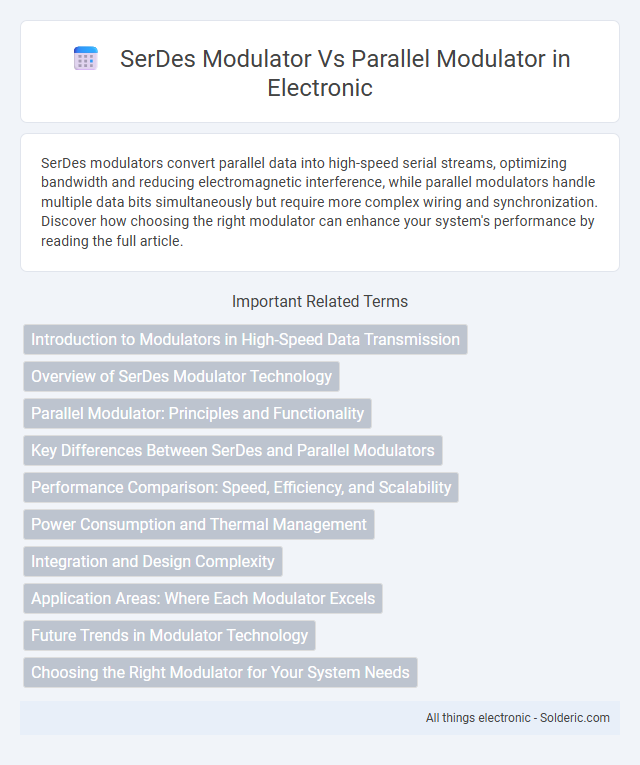SerDes modulators convert parallel data into high-speed serial streams, optimizing bandwidth and reducing electromagnetic interference, while parallel modulators handle multiple data bits simultaneously but require more complex wiring and synchronization. Discover how choosing the right modulator can enhance your system's performance by reading the full article.
Comparison Table
| Feature | SerDes Modulator | Parallel Modulator |
|---|---|---|
| Signal Type | Serial data stream | Multiple parallel data lines |
| Data Rate | High-speed serial transmission | Lower speed per line, aggregate slower |
| Complexity | Complex serializer and deserializer circuits | Simple modulation on individual lines |
| Power Consumption | Optimized, generally lower at high speeds | Higher due to multiple active lines |
| PCB Routing | Reduced trace count, easier routing | More traces, complex PCB layout |
| Latency | Lower latency due to serial processing | Higher latency due to parallel data handling |
| Applications | High-speed data communication, networking | Low-speed, multi-channel systems |
| Cost | Higher initial IC complexity cost | Lower cost, simpler hardware |
Introduction to Modulators in High-Speed Data Transmission
Modulators play a critical role in high-speed data transmission by converting digital signals into formats suitable for efficient transfer over communication channels. A SerDes modulator serializes data, allowing for streamlined, high-bandwidth transmission with fewer physical connections, which reduces signal integrity issues and latency. In contrast, a parallel modulator transmits multiple bits simultaneously across several lines, which can increase throughput but often leads to complexity in synchronization and higher electromagnetic interference.
Overview of SerDes Modulator Technology
SerDes modulators leverage high-speed serial data transmission to convert parallel data into a serialized format, optimizing bandwidth and minimizing pin count on integrated circuits. This technology enhances signal integrity and reduces electromagnetic interference compared to traditional parallel modulators, making it ideal for high-frequency communication systems. By encoding data efficiently, SerDes modulators improve overall system performance and support faster data rates in modern telecommunication and data center applications.
Parallel Modulator: Principles and Functionality
Parallel modulators operate by simultaneously processing multiple data bits across several channels, enabling higher data throughput within a fixed time frame compared to serial modulation. Each channel independently modulates a portion of the input signal, often through amplitude, phase, or frequency shifts, which collectively form the output waveform. This parallel processing reduces latency and is efficient for systems requiring high-speed digital-to-analog conversion and complex signal generation.
Key Differences Between SerDes and Parallel Modulators
SerDes modulators transmit data serially over a single high-speed channel, significantly reducing pin count and improving signal integrity, while parallel modulators send multiple bits simultaneously across several lines, increasing hardware complexity and susceptibility to crosstalk. SerDes technology enables longer distance communication with lower power consumption and higher data rates compared to parallel modulators, which are limited by skew and timing challenges at higher frequencies. The choice between SerDes and parallel modulators depends on system requirements for bandwidth, integration density, and power efficiency.
Performance Comparison: Speed, Efficiency, and Scalability
SerDes modulators excel in speed and scalability by serializing data streams, allowing higher data rates and reduced pin count compared to parallel modulators, which handle multiple bits simultaneously but face limitations in bandwidth and signal integrity at high frequencies. Efficiency in SerDes modulators is enhanced by lower power consumption per bit and simplified PCB layout, whereas parallel modulators endure increased crosstalk and electromagnetic interference challenges. Your choice should consider that SerDes technology offers superior performance for high-speed, scalable systems, while parallel modulators might be suited for lower-speed, cost-sensitive applications.
Power Consumption and Thermal Management
SerDes modulators typically consume less power than parallel modulators due to their serial data transmission, reducing the number of active data lines and lowering overall energy usage. This efficiency results in simpler thermal management requirements, as less heat is generated during operation. Your system benefits from improved power efficiency and reduced cooling complexity when opting for SerDes modulators over parallel alternatives.
Integration and Design Complexity
SerDes modulators offer higher integration by combining serialization and modulation functions into a single chip, reducing the need for multiple discrete components, which simplifies the overall system design. Parallel modulators require separate modulators for each data lane, increasing the complexity of PCB routing and interconnects, leading to larger footprints and potential signal integrity issues. The integrated architecture of SerDes modulators enhances scalability and power efficiency, making them ideal for high-speed, high-density communications compared to parallel modulators.
Application Areas: Where Each Modulator Excels
SerDes modulators excel in high-speed data transmission applications such as telecommunications, data centers, and high-performance computing, where efficient serial-to-parallel conversion reduces wiring complexity and enhances signal integrity. Parallel modulators are preferred in short-distance, lower-speed applications like traditional memory interfaces, industrial automation, and embedded systems due to their simplicity and lower cost. Your choice depends on the required data rate, distance, and system complexity, with SerDes favored for long-distance, high-bandwidth needs and parallel modulators for cost-effective, low-latency environments.
Future Trends in Modulator Technology
Future trends in modulator technology emphasize the shift from parallel modulators to SerDes modulators due to their superior data throughput and reduced pin count, which streamline circuit design and enhance scalability. SerDes modulators leverage high-speed serial interfaces, enabling efficient handling of multi-gigabit data rates essential for 5G, data center, and AI applications. Integration of advanced modulation formats and machine learning algorithms further propels SerDes modulators as the preferred choice in next-generation communication systems.
Choosing the Right Modulator for Your System Needs
Selecting between a SerDes modulator and a parallel modulator depends on data rate requirements and system complexity. SerDes modulators excel in high-speed data transmission by converting parallel data into serial streams, reducing pin count and electromagnetic interference, making them ideal for space-constrained designs. Your system benefits from a parallel modulator when simplicity and lower latency are priorities, especially in applications with moderate data rates and less stringent space constraints.
SerDes modulator vs parallel modulator Infographic

 solderic.com
solderic.com